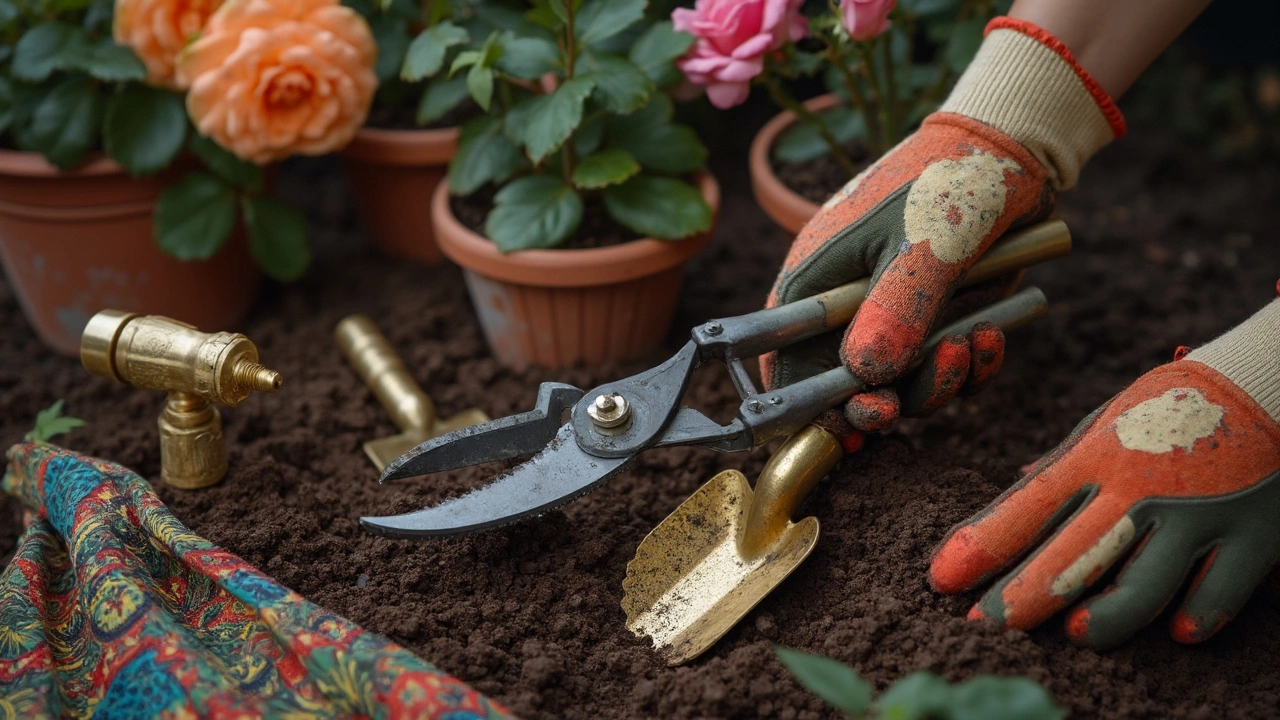If you’ve ever snapped a spade trying to pry up a stubborn root or watched those cheap pruners rust after one rainy week, you know garden hand tools aren’t all created equal. Some just have that feel—sturdy, comfortable, and built for years, not just a single season. The big question: who actually makes this kind of quality?
The answer matters more than you might think. You’re not just buying a trowel or a pair of shears; you’re picking a tool that could be in your hand for hours at a stretch. Nobody wants blisters after fifteen minutes, or a handle that wiggles right from the start. Before you burn cash on another disappointing impulse buy, it’s worth knowing what separates top-shelf tools from the ones that belong in the discount bin.
Whether you’re wrestling with clay soil or fine-tuning your urban balcony jungle, starting with better gear makes the whole job easier. Great tools don’t just last—they make you want to get out and actually use them, even when you’ve got a dozen other things to do. Let’s cut through the brand hype, the myths, and the buzzwords. Here’s what really counts and where to look for garden hand tools that live up to the hype.
- What Really Counts as 'High Quality'?
- Top Brands for Garden Hand Tools
- How to Spot a Tool That Lasts
- Interesting Facts: Vintage Tools vs. Modern Innovation
- Tips: Make Your Tools Last Longer
- Best Bang for Your Buck
What Really Counts as 'High Quality'?
When you’re picking out garden hand tools, forget the shiny packaging and slick advertising. High quality is about real stuff: how the tool is built, what materials go into it, and how it feels in your hand. Start by looking at the metal. The best trowels and pruners use hardened stainless steel or carbon steel. Stainless steel won’t rust easily, and properly made carbon steel holds an edge for ages. Some top brands even use a process called "forging"—heating and hammering the steel—so the metal is one solid piece, which cuts down on weak spots that make cheap tools snap.
Handle materials might sound boring, but they matter just as much. Ash wood is a classic for a reason—it’s tough, absorbs shocks, and if it’s shaped well, your hand won’t get tired. You’ll also see fiberglass and reinforced plastic. Both are light but not all versions are equal. Check for a finish that looks smooth and seamless, not flimsy and brittle.
The real test? Comfort and control. A tool needs good balance so it doesn’t feel awkward after digging a few holes. Look for handles that feel natural, not too fat or skinny. Another detail—joints and rivets. Are the pieces bolted or riveted with metal? Good. Cheap tools often just glue or press-fit parts together, and that’s where things start failing fast.
Here’s how you can spot real garden tools quality at a glance:
- Look for “full tang” designs—where the metal runs all the way through the handle (no hidden plastic bits taking the strain).
- Give a gentle flex to the blade or handle; high quality won’t wiggle.
- Check for a warranty. Some top brands guarantee their tools for life—nobody does that unless they believe in their gear.
- Read the grip: smooth but not slick, and no sharp seams.
Think about your own usage, too. If you break tools regularly, invest in forged blades and solid wood or high-end composite handles. Gardeners who struggle with joint pain should look for ergonomic options — not everyone’s hands are the same, and the right grip shape can save you a lot of discomfort.
Basically, real quality is about what’s under the surface. Don’t get sidetracked by fancy colors or gimmick features. If you pick up a tool and it feels weird or light as a feather (in the bad way), trust your instinct and keep looking.
Top Brands for Garden Hand Tools
If you’re looking for the best garden tools, some names pop up over and over—and there’s a reason for that. These brands actually hold up under real use, whether you’re whipping through weeds or planting rows for hours.
Let’s break down a few heavy hitters and what they’re actually known for:
- Felco (Switzerland): If you talk pruners, people talk Felco. Their red-handled bypass pruners have been the gold standard since 1945. Gardeners and pros love them for their replaceable parts and precise, smooth action. They may cost more, but with proper care, expect them to last decades.
- Fiskars (Finland): Almost every garden center has Fiskars in the lineup. Their orange-and-black tools are easy to spot, and most people find their ergonomic handles and non-stick blades stand up to daily use. Their PowerGear line for loppers and pruners gets high marks for reducing hand strain.
- Sneeboer (Netherlands): Handmade Dutch steel tools, with ash wood handles. Not cheap, but these are for gardeners who never want to replace their spade or fork ever again. Each tool is balanced and finished by hand in a tiny family-run factory.
- DeWit (Netherlands): Family company since 1898 making tough, no-nonsense hoes, trowels, and weeders from boron steel. Gardeners say these feel like old-school tools but with modern comfort. If you’re dealing with rocky or clay soil, DeWit is worth a look.
- Burgon & Ball (UK): British company since 1730, now known for stylish tools and classic stainless-steel trowels. Their Sophie Conran range mixes looks and function, but even their regular line is famous for smooth handles and solid welds.
- Corona (USA): American favorite, especially for affordable, pro-grade hand pruners and loppers. Used a lot in landscaping trades for being tough and easy to find parts for.
Here’s a quick comparison so you can see who shines where:
| Brand | Country | Best Known For | Avg. Price Range (USD) | Warranty |
|---|---|---|---|---|
| Felco | Switzerland | Pruners | $60-$80 | Lifetime (limited) |
| Fiskars | Finland | Pruners, Loppers, Shears | $20-$50 | Lifetime (varies) |
| Sneeboer | Netherlands | Spades, Forks, Hand Tools | $60-$120 | Lifetime |
| DeWit | Netherlands | Trowels, Hoes, Weeders | $30-$75 | Lifetime |
| Burgon & Ball | UK | Trowels, Forks | $20-$50 | Lifetime |
| Corona | USA | Pruners, Loppers | $20-$40 | Lifetime (limited) |
These brands didn’t just drop onto shelves overnight. They’ve been tested in muddy gardens, on rocky plots, and by people who actually love putting in the work. If you’re just building your kit or sick of broken handles, picking a tool with one of these names usually means you’ll get more for your money—maybe even a lifetime’s worth.
How to Spot a Tool That Lasts
Ever grabbed a hand trowel and—right away—you just know it’s not going to survive a season? There’s a knack to telling the difference between a throwaway and one that’ll outlive your gardening boots. You don’t need X-ray vision—just keep an eye out for a few key things the pros swear by.
- Material matters most. Forget thin, painted steel or weird alloys. Go for stainless steel or high-carbon steel. Stainless doesn’t rust easily and wipes clean after mud-caked jobs. High-carbon steel stays super sharp, great for pruners and loppers. Wood handles? Ash or hickory last way longer than cheap pine or plastic. Bonus points for a raw, unfinished wood grip—it won’t splinter and feels solid.
- Check the join. If the blade or shovel head is just glued or stapled to the handle, don’t even bother. The best garden tools use one solid piece of metal (look up "full-tang construction"). For rakes and hoes, you want a steel socket welded or riveted deep into the handle, not just a stub pushed in an inch or two.
- Feel the weight. Quality tools are usually heavier. Not uncomfortably so, but you should feel a bit of balance. Feather-light tools tend to bend or snap under real work. Try picking up a Felco pruner or a Sneeboer trowel for comparison—these have some heft, and that’s a good thing.
- Try the grip test. Wrap your hand around the handle and do a few mock moves. Is it comfy? Any big seams or cheap rubber that’s already peeling is a red flag. Ergonomic shapes are great, but only if they’re well made. Fiskars, for example, is known for handles that fit most hands without slipping.
- Ask about the warranty—really. Most top brands stand behind their stuff for life, or at least a couple decades. Bulldog, for example, has been around since the 1700s and offers a lifetime guarantee on many of their tools.
One last thing—buying in person lets you see and feel what you’re getting. If you shop online for the best hand tools, double-check close-up photos and reviews that mention sturdiness and materials, not just how "cute" the thing looks. Don’t fall for shiny. Fall for sturdy.

Interesting Facts: Vintage Tools vs. Modern Innovation
Start poking around garage sales or your grandparents’ shed, and you’ll spot something wild: vintage garden tools that are decades old but still going strong. A lot of these old-school pieces, like forged steel hand forks or heavy-duty hoes made in the 1940s or 50s, are often sharper and sturdier than stuff you find brand new today. Back then, handles were almost always ash or hickory, not plastic, and blades were thick enough to handle serious abuse.
One of the top reasons people still hunt down old hand tools at flea markets is because they’re so hard to break. Brands like Bulldog, Sneeboer, and even old Stanley hand shears were designed before ‘cost cutting’ was even a thing. These tools could easily outlast their owners—some gardeners pass them down like family recipes. That’s not nostalgia; it’s plain tough engineering.
But don’t count out modern innovation just yet. Advances in materials and ergonomics have made huge strides. Companies like Fiskars and Felco use high-carbon alloys, lightweight aluminum, and ergonomic grips that save your wrists, especially if you garden every weekend. Some new trowels now come with rust-proof coatings or lifetime warranties. You’ll even find pruners with replaceable blades and shock-absorbing handles—tricks the old-timers never even dreamed of.
Compare a garden tool shelf from 1950 and one from 2025 and you’ll see a different picture. Old tools often last longer, but new tech has made gardening way easier on your body. The smartest move? Mix and match. A tough old spade and modern pruners make a great toolkit. If you spot a vintage tool in good shape at a tag sale, grab it. If you want comfort for hours, don’t be shy about new grips and lightweight builds.
- Vintage brands like Bulldog and Sneeboer are still producing tools using traditional designs.
- Modern innovations focus on lighter handles, anti-blister grips, and rust-resistant metals.
- Some gardeners swear by restoring and sharpening old tools—they’re made to be brought back to life.
- Big retailers now offer collections inspired by classic designs, with today’s new materials.
- You can often fix an old tool, but some modern tools aren’t made to be repaired—watch out for that.
Tips: Make Your Tools Last Longer
Your tools work hard, but a little TLC goes a long way when it comes to garden gear. Even the best hand tools can become stiff, rusty, or cracked if you just toss them in the shed after every use. The way you clean, store, and maintain your tools plays a huge part in how long they stick around.
Start with cleaning. After each use, rinse off any soil, sap, or plant debris. Concrete mud can trap moisture and lead to rust. A stiff brush and a quick spray with a hose does the job for most hand tools. For pruners and shears, wipe down the blades with a rag and a little isopropyl alcohol to keep sap from turning sticky — this also kills off bacteria and can help prevent spreading plant diseases.
Next, dry your tools completely. Don’t just leave them to air dry if you want them to stay in good shape. Water that collects in cracks or crevices will corrode metal over time. It might sound obvious, but a lot of people skip this step, which is why rust is the most common issue with garden tools.
- Sharpen stuff regularly. Dull blades make you work harder and can actually damage plants by tearing stems instead of slicing cleanly. Most garden centers sell small sharpening stones for about the price of a cup of coffee.
- Oil any moving parts. A drop or two of mineral oil on hinges or springs keeps pruners and shears working smoothly. For wood handles, rub on boiled linseed oil to stop them from drying out and cracking, especially after a wet season.
- Store your tools inside. Leaving them outside overnight, even just once, is asking for trouble. A basic rack or even a bucket of sand with a dash of mineral oil (an old-school trick) keeps rust at bay and handles dry.
Real talk: more than half of broken hand tools come from folks prying up rocks or roots with stuff made only for soil. Use the right tool for the job, and you’ll see way fewer cracked handles and bent blades.
| Maintenance Habit | How Much It Increases Tool Lifespan (based on surveys) |
|---|---|
| Cleaning after each use | Up to 3x longer lifespan |
| Storing tools indoors | 2x less rust and handle rot |
| Sharpening blades yearly | Cutting performance lasts up to 70% longer |
Look, your tools aren’t invincible, but a few minutes of care here and there means you won’t be hitting the hardware store every spring for replacements. That’s more cash and less hassle — always a win.
Best Bang for Your Buck
Quality gardening doesn’t mean dropping half your paycheck at the store. You can find top-notch garden tools without getting ripped off—if you know where to look and what to pick. Some brands just give you way more value for your money. For example, Fiskars is famous for tough shears and loppers that stay sharp for years but cost less than most premium brands. Spear & Jackson, coming out of the UK, balances price and steel quality better than many high-end names, especially for digging tools.
Japanese brand Okatsune keeps popping up in online gardening groups and even among pro landscapers. Their pruners run around $35-$50, but you get pro-level blades that outlast most big box store picks—worth it, especially for anyone who hates sharpening their tools every spring. Corona is another strong value pick, especially for anyone in the U.S. Their forged steel pruners and rakes stand up to heavy use and usually come with a limited lifetime warranty.
Here’s a quick hit list for stretching your dollars further:
- Skip cheap three-piece kits—they look good in the box but break fast and nearly always rust.
- Watch for mid-range lines from big names. Fiskars' "Softgrip" series is cheaper than their "Pro" line but still way sturdier than no-name stuff.
- Don’t ignore warranties. Companies like Corona and Felco back up their tools, so if anything cracks, you aren’t stuck eating the loss.
- Amazon reviews are decent, but Reddit (like r/gardening) is gold for brutally honest feedback if you want the real scoop before you buy.
Bottom line: Don’t pay just for a logo, but don’t grab the cheapest option you see, either. A tool that costs a little more up front, holds up for years, and saves you from repeat buys almost always ends up costing less over time. Watch for sales late summer or early fall—that’s when some of the better tools get marked down and you can seriously win big.





